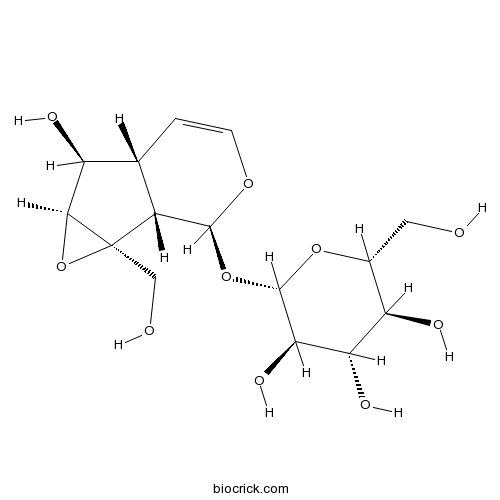InChI=1S/C15H22O10/c16-3-6-9(19)10(20)11(21)14(23-6)24-13-7-5(1-2-22-13)8(18)12-15(7,4-17)25-12/h1-2,5-14,16-21H,3-4H2/t5-,6-,7-,8+,9-,10+,11-,12+,13+,14+,15-/m1/s1
Catalpol, an iridoid glucoside, has been reported to inhibit apoptosis of neuron and endothelial cells; the pretreatment of H9c2 cells with catalpol can be against H 2 O 2 -induced apoptosis, and the protective effect of catalpol involves the mitochondrial-dependent caspase pathway and is associated with increased Bcl-2 and decreased Bax expression.[1]
Catalpol has the neuroprotective effects of in lipopolysaccharide (LPS)-induced inflammatory models, it can prevent mesencephalic neuron death and ameliorate cognitive ability animals; catalpol can exert inhibitory effects on the inflammatory reaction in astrocytes and that inactivation of NF-κB could be the major determinant for its anti-inflammatory mechanism, therefore, it may potentially be a highly effective therapeutic agent in treating neurodegenerative diseases associated with inflammation.[2]
Catalpol exerts the most significant cytoprotective effect on astrocytes by suppressing the production of free radicals and elevating antioxidant capacity.[3]
Catalpol can increase presynaptic proteins and up-regulate relative signaling molecules in the hippocampus of the aged rats, it seems to indicate that catalpol might ameliorate age-related neuroplasticity loss by “normalizing” presynaptic proteins and their relative signaling pathways in the aged rats.[4]
[1] Hu L A, Sun Y K, Zhang H S, et al. Bioscience Reports, 2016,36(3).
[2] Bi J, Jiang B, Zorn A, et al. Toxicol in Vitro, 2013, 27(2):543-50.
[3] Li Y, Bao Y, Bo J, et al. Int J Dev Neurosci, 2008, 26(3–4):309-17.
[4] Liu J, He Q J, Zou W, et al. Brain Res, 2006, 1123(1):68-79.
[5] Sun L L, Ren Y H, Chen H L, et al. China Pharmacy, 2013(04):374-5.



